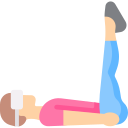
Yoga Breathing Exercises for Weight Management: Calm, Control, and Sustainable Change
Today’s chosen theme: Yoga Breathing Exercises for Weight Management. Discover how intentional breath can steady cravings, reduce stress hormones, and create lasting momentum. Join our community, share your progress, and subscribe for weekly breath-focused guidance and encouragement.



Pranayama Techniques That Support Fat Loss
Kapalabhati to Spark Energy Without Jitters
With passive inhales and brisk, active exhales, Kapalabhati can lift morning energy and mental clarity. Start gently: one round of thirty pulses, rest, then another. Keep it nasal, upright, and stop if dizziness appears. Consistency beats intensity.
Bhastrika with Respectful Boundaries
Bhastrika’s strong, even inhales and exhales can feel invigorating yet demanding. Practice short sets, then pause. Those with blood pressure concerns should consult a professional first. Use it to replace afternoon caffeine and stabilize focus without a crash.
Nadi Shodhana for Craving Control
Alternate nostril breathing calms anxious impulses that masquerade as hunger. Inhale left, exhale right; inhale right, exhale left. Five minutes before dinner can soften urgency, making mindful portions and slower bites feel surprisingly natural and satisfying.

Daily Integration: Make Breathwork Effortless
Before opening another tab or message, inhale for four counts, exhale for six, repeating ten times. This micro-reset lowers stress, reduces snack-driven procrastination, and nudges your brain toward focused action instead of searching for sugary stimulation.
Daily Integration: Make Breathwork Effortless
Sit tall, three minutes nasal breathing, exhale slightly longer. Name your intention—nourish, not numb. You will notice flavors more distinctly, chew slower, and feel fullness sooner. Share your favorite pre-meal mantra with us and inspire others.
Daily Integration: Make Breathwork Effortless
Practice 4-7-8 breathing in bed: inhale four, hold seven, exhale eight. Deeper sleep supports glucose regulation and appetite hormones. Track your bedtime practice for two weeks and comment with changes in morning hunger and mood.
Breath, Movement, and Nutrition—A Supportive Trio
Breath-Paced Walking
Try four steps inhale, six steps exhale. This rhythm encourages fat-oxidation friendly pacing and clears mental clutter. Share your favorite route and step-breath ratio; your tip might help another reader reclaim consistent morning walks.


Slow Flow, Strong Core
Pair diaphragmatic breathing with slow vinyasa or stability poses. Exhale during effort, inhale during expansion. Expect steadier form, reduced strain, and a calmer mind that avoids “reward” overeating after workouts. Tell us which pose-breath combo feels best.
Measure What Matters and Stay Motivated
Breath Log and Energy Notes
Record minutes practiced, perceived stress, and post-meal fullness. Look for patterns: fewer cravings on Nadi Shodhana days, better focus after Kapalabhati. Share a snapshot of your week in the comments and compare lessons respectfully.
Habit Stacking that Actually Sticks
Attach breathwork to daily anchors: coffee brewing, commute parking, or brushing teeth. Two minutes here, three there. Celebrate streaks, not perfection. Invite a friend to join and subscribe together for monthly challenges and gentle accountability.
Milestones Beyond the Scale
Note calmer meals, improved sleep, and choosing fruit over chips after a long day. These momentum markers predict durable weight changes. Tell us your latest non-scale victory and cheer on someone who needs encouragement today.
Safety, Contraindications, and Personalization
If you have respiratory, cardiovascular, or anxiety conditions, consult a healthcare professional before strong pranayama. Start with gentle diaphragmatic breathing and Nadi Shodhana. Listen for dizziness, tingling, or strain—those signals deserve respect and adjustments.

